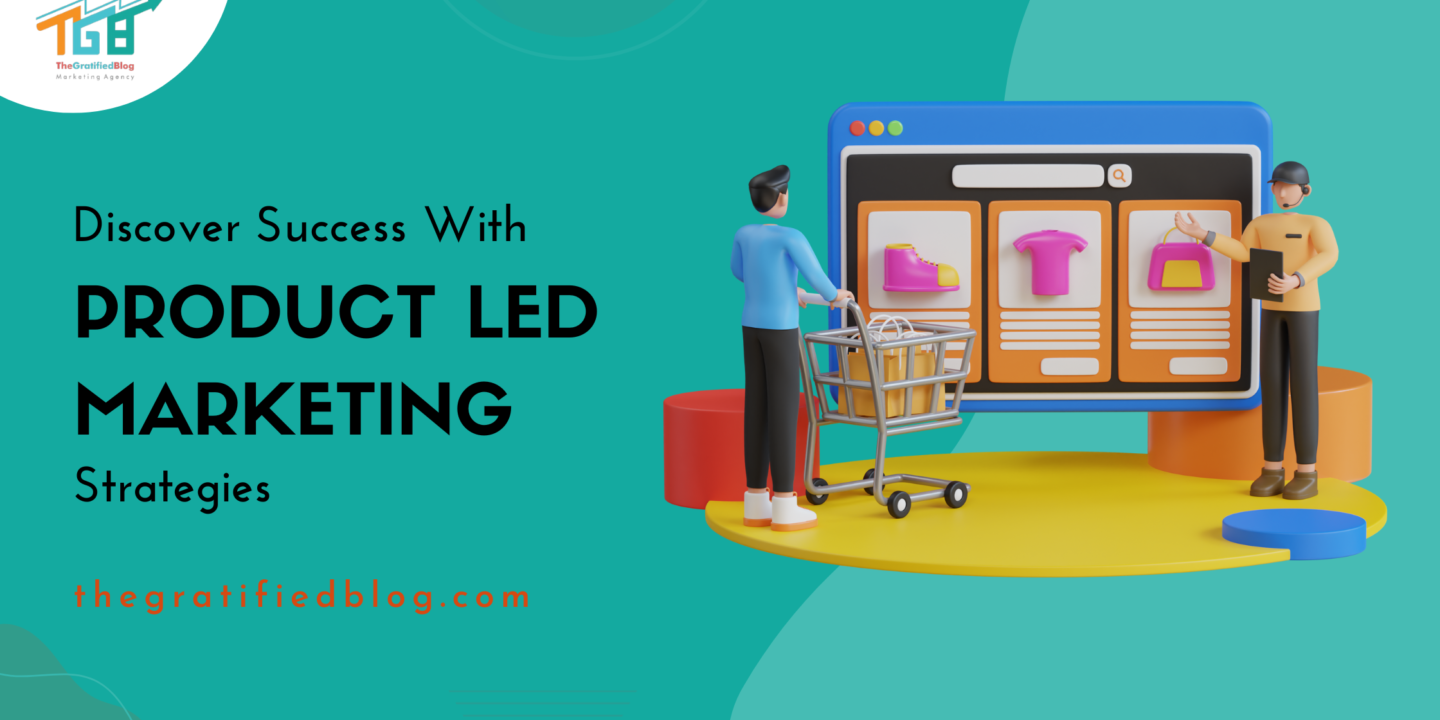
In today’s dynamic business landscape, where customer preferences and market trends evolve rapidly, a strategic approach known as product-led marketing has emerged as a catalyst for sustainable growth and market success.
This comprehensive blog post delves deep into product led marketing, exploring its core principles, implementation strategies, benefits, challenges, and examples. Whether you’re a new business aiming to innovate the industry or a well-established company aiming to enhance customer loyalty and lifetime value, understanding and harnessing the power of product led marketing is essential for staying competitive and driving meaningful business outcomes.
Join us on this journey as we unravel the key insights and actionable strategies that can propel your organization towards marketing excellence and customer-centric success.
So, let’s get started:
Definition Of Product Led Marketing
Product-led marketing is a strategic approach that centres around the product as the primary driver of marketing and customer acquisition efforts.
Contrary to conventional marketing approaches that heavily depend on promotional campaigns and sales tactics, product-led marketing focuses on creating a compelling product experience that naturally attracts and retains customers.
Benefits Of Product Marketing

- Improved Customer Acquisition: Product led marketing excels at attracting new customers through a seamless and compelling product experience. By focusing on delivering value upfront and showcasing the product’s benefits early in the customer journey, businesses can more effectively capture the attention of potential buyers. This method frequently results in increased conversion rates and a lower cost per acquisition, as happy customers tend to endorse the product to others, fostering natural growth and broadening the customer pool.
- Increased Customer Retention: One of the critical strengths of product led marketing is its ability to foster strong customer relationships and promote loyalty. Businesses can reduce churn rates and retain customers over the long term by continuously delivering value through product updates, personalized experiences, and responsive customer support. A satisfied customer who experiences ongoing value from the product is less likely to switch to a competitor, contributing to a stable and loyal customer base.
- Enhanced Product Adoption and Usage: It encourages active engagement and exploration of the product’s features and functionalities. Through intuitive onboarding processes, user-friendly interfaces, and targeted educational resources, businesses can fully empower customers to adopt and utilize the product to its maximum potential. This increases user satisfaction, strengthens the product-market fit, and enhances overall customer experience, driving sustained usage and value creation.
- Higher Customer Lifetime Value: By prioritizing the delivery of continuous value and fostering customer success, product-led marketing leads to an increase in customer lifetime value (CLV). Satisfied customers who derive significant benefits from the product will likely make repeat purchases upgrade to premium offerings, and become advocates for the brand. This leads to increased revenue per customer over their lifetime, contributing to the overall profitability and growth of the business.
Having grasped the concept and advantages of product led marketing, let’s delve into the practical implementation of this strategy.
Implementing Product Led Marketing Strategies

Implementing product-led marketing strategies involves key steps for driving customer engagement, retention, and business growth. Here’s a detailed explanation of each step:
Customer Segmentation And Targeting
- Identify Customer Segments: Start segmenting your target audience based on demographics, psychographics, behaviour, and needs. This helps in understanding different customer groups and their specific requirements.
- Prioritize High-Value Segments: Identify segments with the highest potential value to your business, such as early adopters, high-spenders, or key influencers. Direct your marketing initiatives toward these segments to maximize ROI.
- Tailor Messaging and Offers: Develop personalized marketing. Craft messages and offers that align with the preferences of each customer segment. Use segmentation data to create targeted campaigns that address each group’s unique pain points and preferences.
Onboarding And User Experience Design
- Streamline Onboarding Processes: Design a seamless onboarding experience that guides new users through the product’s features and benefits. Use interactive tutorials, tooltips, and guided tours to help users get started quickly.
- Optimize User Interface (UI): Invest in UI design to create an intuitive, user-friendly interface. Ensure that the product layout, navigation, and user interactions are straightforward and comprehensible for all skill levels.
- Personalize User Journeys: Customize user experiences based on user behaviour, preferences, and goals. Tailor onboarding flows and feature recommendations to align with each user’s specific needs and objectives.
Data-Driven Decision-Making
- Collect Relevant Data: Implement robust data collection mechanisms to gather user feedback, behaviour data, and performance metrics. Use analytics tools to track key metrics related to user engagement, retention, conversion rates, and product usage.
- Analyze and Interpret Data: Use data analytics to derive actionable insights and identify trends, patterns, and areas for improvement. Analyze user feedback, survey responses, and user interaction data to understand user satisfaction levels and pain points.
- Make Informed Decisions: Use data-driven insights to make informed marketing and product decisions. Prioritize initiatives that are backed by data and have the potential to drive significant impact on user experience and business outcomes.
Customer Feedback Loops And Iterations
- Collect Ongoing Feedback: Establish continuous feedback loops to gather user feedback at various touchpoints, such as after onboarding, during product usage, and post-purchase. Use surveys, feedback forms, and in-app prompts to solicit user feedback.
- Actively Listen and Respond: Listen to customer feedback and promptly address concerns or suggestions. Use feedback management systems to categorise feedback, prioritise issues, and track resolution progress.
- Iterate and Improve: Use customer feedback to iterate and improve product features, usability, and overall customer experience. Implement agile development methodologies to quickly iterate on product enhancements based on user feedback and market insights.
After understanding how to implement these product-led marketing strategies, let’s now discuss the typical challenges faced in product-led marketing.
Challenges Of Product Led Marketing

- Initial resource and investment requirements: One of the challenges of product-led marketing is the significant initial resource and investment requirements. Developing a high-quality product with a compelling user experience often requires substantial financial resources, time, and expertise. This includes investments in product design, development, testing, and ongoing optimization. Small and startup companies may need help to allocate sufficient resources to build and promote a product that aligns with customer expectations and distinguishes itself in a competitive market.
- Balancing product development with marketing efforts: Another challenge is striking the right balance between product development and marketing efforts. While focusing on creating an exceptional product experience is crucial, neglecting marketing and customer acquisition strategies can hinder reaching the target audience effectively. It requires careful planning and coordination between product and marketing teams to ensure product launches are supported by effective marketing campaigns and promotional activities to drive user adoption and engagement.
- Adjusting to evolving customer expectations and market trends: Product-led marketing also faces the challenge of Responding to evolving customer expectations and shifts in market trends. Technological advancements, industry shifts, and competitive offerings influence customer preferences, behaviours, and needs to grow. Businesses must stay agile and responsive to these changes by continuously gathering customer feedback, monitoring market trends, and iterating on product features and marketing strategies. Failure to adapt quickly to changing customer demands can result in losing market relevance and competitive advantage.
Now that you know the challenges, let’s explore a few examples of this strategy.
Examples Of Product Led Marketing
Airtable

Airtable combines the functionality of an Excel spreadsheet with that of a relational database, creating a versatile tool for organizing and managing data. Embracing a product-led approach, Airtable recognizes the importance of multi-user adoption within companies to enhance customer retention. Upon a company member’s sign-up, users are directed to a screen encouraging them to invite other team members, fostering collaboration and engagement within the platform.
Furthermore, Airtable incentivizes word-of-mouth marketing by offering a $10 credit for each successful invitation of a new user to the platform. This strategy encourages existing users to advocate for Airtable and fuels organic growth through referrals, strengthening the product’s market presence and customer base.
Slack

Slack, known for its team collaboration and communication software, is a prominent example of a product-led company. It employs various strategies to fuel its growth. Users can effortlessly create a free account with Slack, accessing the product’s core features and experiencing its value firsthand.
Alongside its user-friendly interface, Slack utilizes targeted messaging to encourage user adoption and promote upselling opportunities, enhancing the overall user experience.
Tools And Technologies For Product Led Marketing

Customer Relationship Management (CRM) Systems:
- Salesforce: Salesforce is a widely used CRM Platform that provides various functionalities for handling customer relationships, sales processes, and marketing campaigns. It enables businesses to monitor customer engagements and store contact details, manage leads and opportunities, and automate workflows. Salesforce also offers analytics and reporting features for analyzing customer data and making data-driven decisions.
- HubSpot CRM: HubSpot CRM is a user-friendly solution for small to mid-sized businesses. It offers tools for managing contacts, tracking deals, and organizing customer communication. HubSpot CRM integrates with other HubSpot tools for marketing automation, email marketing, and customer support, providing a comprehensive platform for managing customer relationships across the entire customer lifecycle.
- Zoho CRM: Zoho CRM is a cloud-based CRM software that offers customizable modules for sales automation, marketing automation, and customer support. It provides lead management, pipeline tracking, email integration, and reporting features. Zoho CRM offers AI-powered insights and predictive analytics to help businesses identify sales opportunities and optimize customer engagement.
Product Analytics Platforms:
- Google Analytics: Google Analytics is a robust web analytics tool that offers insights into website and app performance. It tracks user behaviour, traffic sources, conversion rates, and engagement metrics. Google Analytics offers customizable dashboards, reports, and data visualization tools to analyze user interactions and optimize marketing strategies.
- Mixpanel: Mixpanel is a product analytics platform focusing on user behaviour analysis and retention metrics. It allows businesses to track user actions, segment users based on behaviour, and analyze user journeys. Mixpanel offers funnel analysis, cohort analysis, A/B testing, and personalized messaging to drive product optimization and user engagement.
- Amplitude: Amplitude is a comprehensive product analytics platform that helps businesses understand user behaviour, measure product usage, and optimize customer experiences. It offers features in event tracking, user segmentation, behavioural cohorts, and predictive analytics. Amplitude’s analytics tools enable businesses to identify product strengths, detect usage patterns, and make data-driven decisions to improve product performance.
Marketing Automation Tools:
- Mailchimp: Mailchimp is a widely used platform for email marketing and automation that empowers businesses to design, dispatch, and track email campaigns. It offers features such as email templates, audience segmentation, A/B testing, and marketing automation workflows. Mailchimp also provides tools for analytics and reporting, allowing businesses to measure campaign effectiveness and customer engagement.
- Pardot: Pardot is a marketing automation platform tailored for B2B businesses by Salesforce that specialises in lead generation, lead nurturing, and marketing ROI measurement. It offers lead scoring, email drip campaigns, landing page creation, and marketing analytics. Pardot integrates with Salesforce CRM for seamless data synchronization and sales alignment.
User Feedback and Survey Platforms:
- SurveyMonkey: SurveyMonkey is a commonly utilized platform for online surveys. It allows businesses to create and distribute surveys to gather customer feedback. It also provides analytics tools to analyze survey responses, create reports, and gain actionable insights.
- Qualtrics: Qualtrics is an enterprise-grade survey and feedback management platform that enables businesses to gather feedback across various touchpoints, including customer experience surveys, employee feedback surveys, and market research studies. It offers advanced survey design capabilities, real-time reporting, and text analytics for sentiment analysis.
- UserVoice: UserVoice is a platform dedicated to collecting customer feedback that helps businesses collect, prioritize, and act on customer feedback. It allows users to submit ideas, report issues, and vote on feature requests. UserVoice provides tools for feedback management, idea prioritization, and customer engagement, enabling businesses to improve product offerings based on user input.
FAQs
Q1. What is product-led marketing?
A. Product-led marketing is a strategic approach that considers the product the critical driver of customer acquisition efforts, engagement, and retention. It focuses on creating a compelling product experience that naturally attracts and retains customers, leading to sustainable growth and customer loyalty.
Q2. How does product-led marketing differ from traditional marketing?
A. Unlike traditional marketing, which relies heavily on promotional tactics and sales efforts, product-led marketing emphasizes delivering value through the product experience. It focuses on providing solutions to customer pain points, fostering user engagement, and leveraging product usage as a critical driver of marketing success.
Q3. What are some benefits of adopting a product-led marketing strategy?
A. Adopting a product-led marketing strategy can improve customer acquisition, retention, product adoption and usage, customer lifetime value, and a customer-centric culture within the organization. It aligns marketing efforts with product development, driving meaningful customer relationships and business growth.
Conclusion
Having gained an understanding of product-led marketing, it’s evident that this approach prioritizes the product’s role in driving customer acquisition and retention. By delivering value through the product experience, businesses can create a customer-centric approach that fosters user engagement, enhances product adoption, and builds long-term customer loyalty.
However, if you still have any questions related to the blog, please feel free to leave them in the comment section. We will be happy to answer them.
Thanks for reading 🙂








No Comments